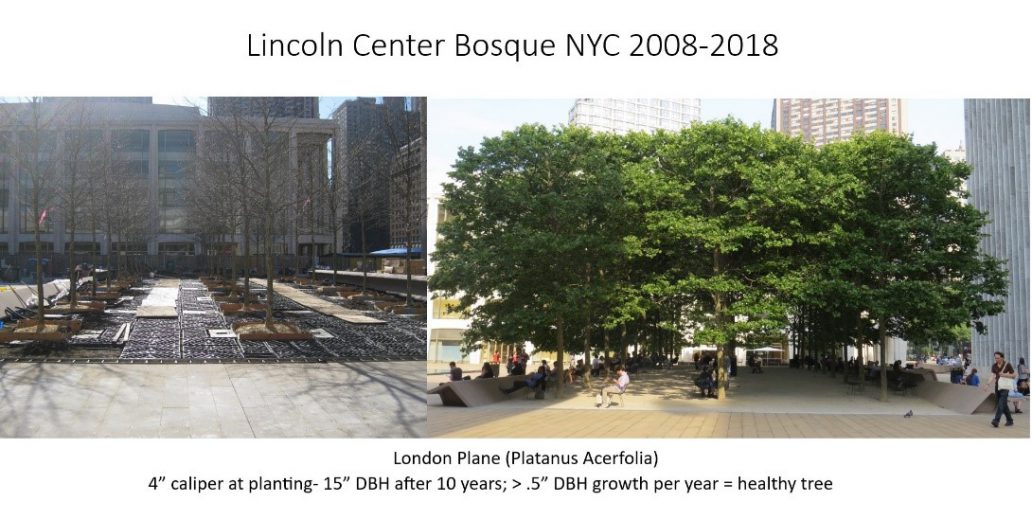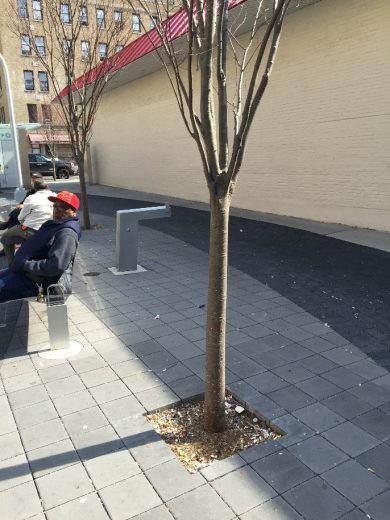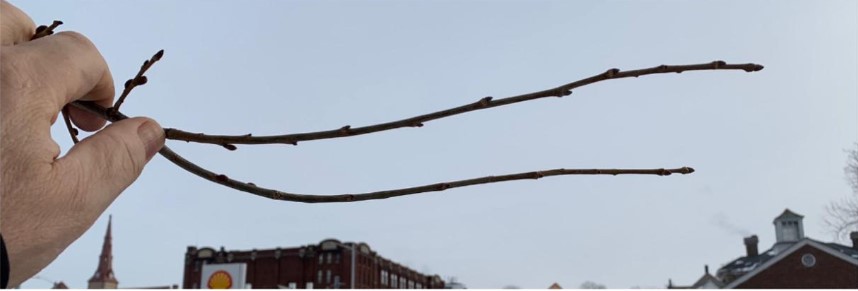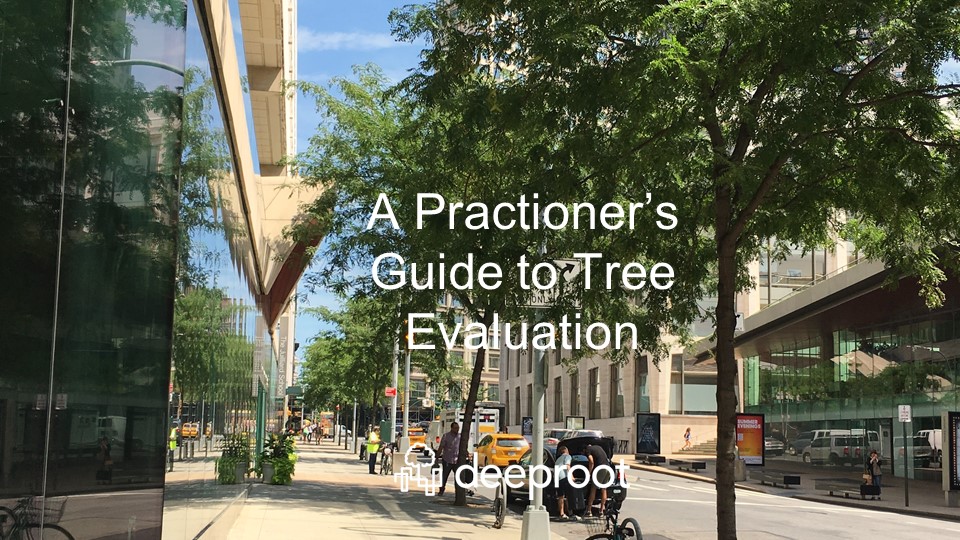I often cruise around checking in on Silva Cell projects throughout the seasons and take some random data on how the trees are doing. The data is helpful for established and new clients to show the efficacy of Silva Cells. My study concerns deciduous trees. I also usually point to this piece of content on Growth Rates and Performance of Trees in Silva Cells.
Evaluating tree planting response can get very qualitative. There are many ways to discern tree health. A slew of methods can be seen on LinkedIn’s urban forestry discussion group page. Other methods include looking at leaf area index (LAI). These methodologies were developed by Jerry Bond of Urban Forest Analytics – Analysis of urban trees and forests who looked into site characteristics and distances and their potential influences on land uses such as roads and buildings. DeepRoot’s close friend Peter MacDonagh, FASLA, has also written about this subject, and we have published it on our blog: 13 Simple Steps to Evaluate Trees | DeepRoot Blog
As a non-arborist looking to get a quick sense of urban tree health in the field, I use the following simple and efficient methods to evaluate tree plant response:
Diameter Breast Height (DBH)z
Taken at 4.5’ above the ground, to eliminate the variability of trunk flare, DBH is a relatively easy measurement and proxy for overall tree health. If the tree is putting on less than a quarter of an inch per year in trunk size, there is a separate problem. Even slow-growing trees like gingkoes (Gingko Biloba) or dogwoods (like Cornus Kousa) will put on this .5” dimension. The problem with DBH is that it’s evaluated year over year, and one must come back multiple times to read it. We at DeepRoot often know what the caliper of the tree was when it went in the ground because we often obtain the planting lists in the project bid documents. So we can then estimate the yearly growth, but we will do that only for prominent projects like the Lincoln Center bosque in NYC.
 Trunk Evaluation
Trunk Evaluation
Take a look at how the tree enters the soil. If you can see trunk flare, it was likely harvested and planted well. If the trunk flare comes out of the ground like a stovepipe, then it was either a nursery stock problem in that the root ball was buried in the harvesting process, or the root ball was planted at the wrong height and someone filled in the area above it to cover the shoddy work. I would say this is the number one mistake DeepRoot sees in Silva Cell projects and the reason why we see variability in the plant response of our projects. Often in our projects (which are all trees in pavement), the minimalist design construct is to have an architectural bough of the tree ascending directly out of the pavement, with no trunk flare or mulch. These involve using products like tree grates or resin bonded aggregates over the root ball and between the tree and where the pavement really starts. These treatments inhibit quick evaluation, and I always wonder why people don’t use mulch, which is healthy for the tree and can be easily removed for evaluation.
Surface Roots
If the tree does have trunk flare, and you can see it, take a look at the surface roots to discern if there are girdling roots or if they radiate away from the trunk like petals on a daisy. If the former, it should have been corrected in the nursery, and if the latter, it is a properly grown and harvested tree.
Bark Evaluation
Take a look at the bark. Are there any trunk wounds? Is the trunk largely healthy? Is there any moss or fungus on the bark? If so, how much? Are there a bunch of wounds from planting or maintenance or abuse? Is there adventitious shooting of small twigs coming out of the trunk? Obviously, the fewer wounds the better. A healthy tree will not have any of the above and will not require mediation.
Canopy Evaluation
As noted above, one can use LAI (leaf area index) to quantify the density of canopy leaves, but a quick look will suffice. If you can’t see through the canopy even on a tree with a more open habit such as Honey Locust (Gleditsia Triacanthos), it’s in really good shape. If the canopy is patchy, leggy, or has large holes, it’s not a sign of good health. Also, researchers use chromatographs to evaluate color, but quick visual inspection can give you a sense that the darker and less splotchy the leaves are, the better the health of the tree. In colder climates, salt damage in the leaves can be evident. Airborne salt is often only on one side of the tree (by a roadway) and waterborne salt you can see in the first leaves, and they will brown and curl.
Canopy structure is also important. Often, young trees in the nursery don’t display a central leader and have many branches emanating at the same height. These structural deficiencies should be corrected as early as possible and can be avoided entirely with proper nursery selection and growers adhering to ANSI standards.

Healthy trees that need structural pruning
Twig Extension
My favorite method of tree health evaluation is twig extension. This is great because you can see year-over-year growth in just one visit to the tree. Every branch has a small scar that indicates how much it grew the previous year. Simply measure the distance between these terminal bud scars and the end of the branch to determine how much growth the tree is putting on. If the tree has growth from the previous year’s bud scar to the tip of 10–20 inches, it’s doing GREAT, particularly in the two years after transplant. This evaluation also works in wintertime, as the trees are dormant and are not in full leaf. Also, check the buds to see if they are hard. That is an indication they are ready for bud break. The problem with this method is that it is highly variable, and it may be a good indicator only on a portion of the tree. If there is consistent growth from year to year, over the entire tree, and across the trees planted adjacently , it’s a good bet the tree is in good health.

12” twig extension evident in dormant branch, 1.5 years after planting. Looking good!
Conclusions
You can see from this discussion that I travel around the Eastern U.S. and Midwest a lot to evaluate our sites. Sometimes, I will let the owners know that trees need to be remediated. Careers are made on arboricultural remediation, and this blog is about identification.
The best thing that anybody can do after a preliminary evaluation like this is call in a certified or consulting arborist at ISA or the American Society of Consulting Arborists to carry out fixes and remediation, so these warning signs don’t progress to a hazardous condition resulting in the tree being removed.
We have also written extensively about soil evaluation, which can really affect tree growth.





